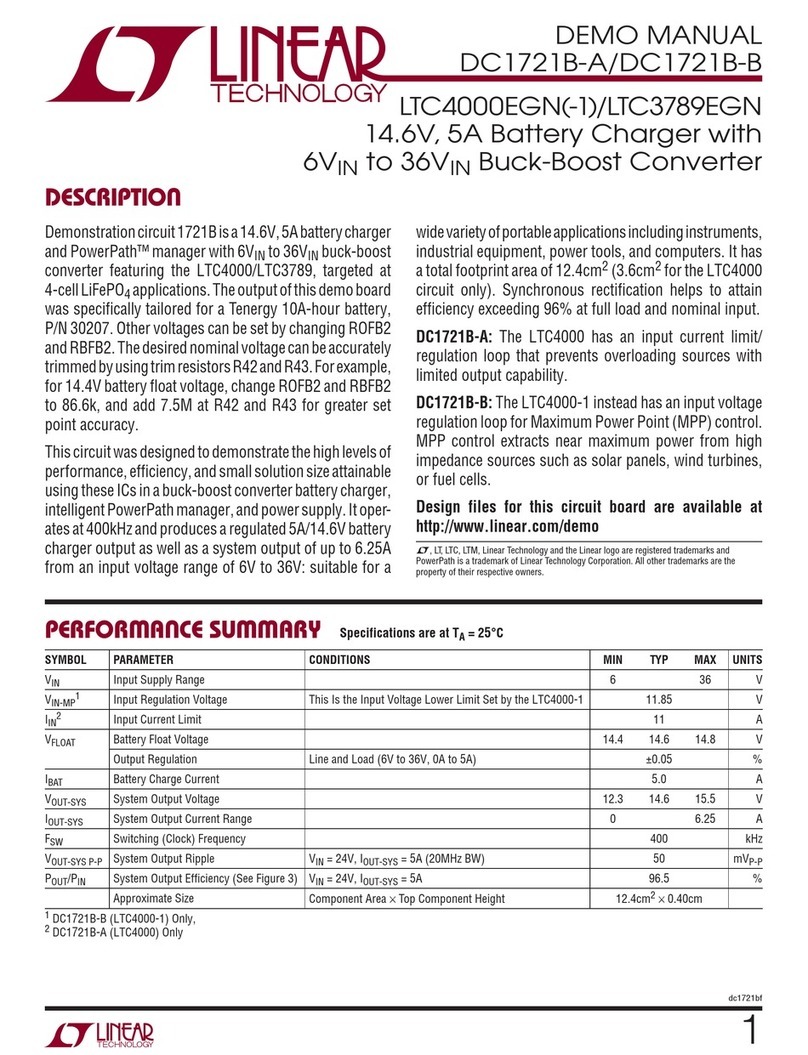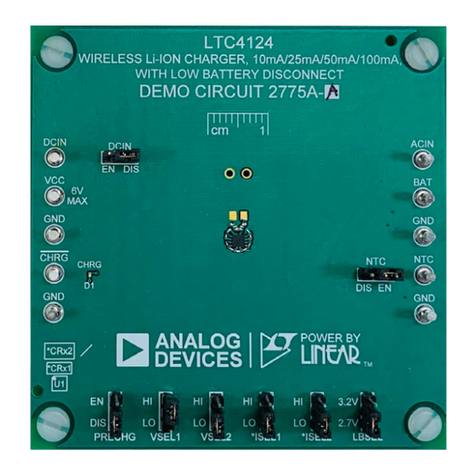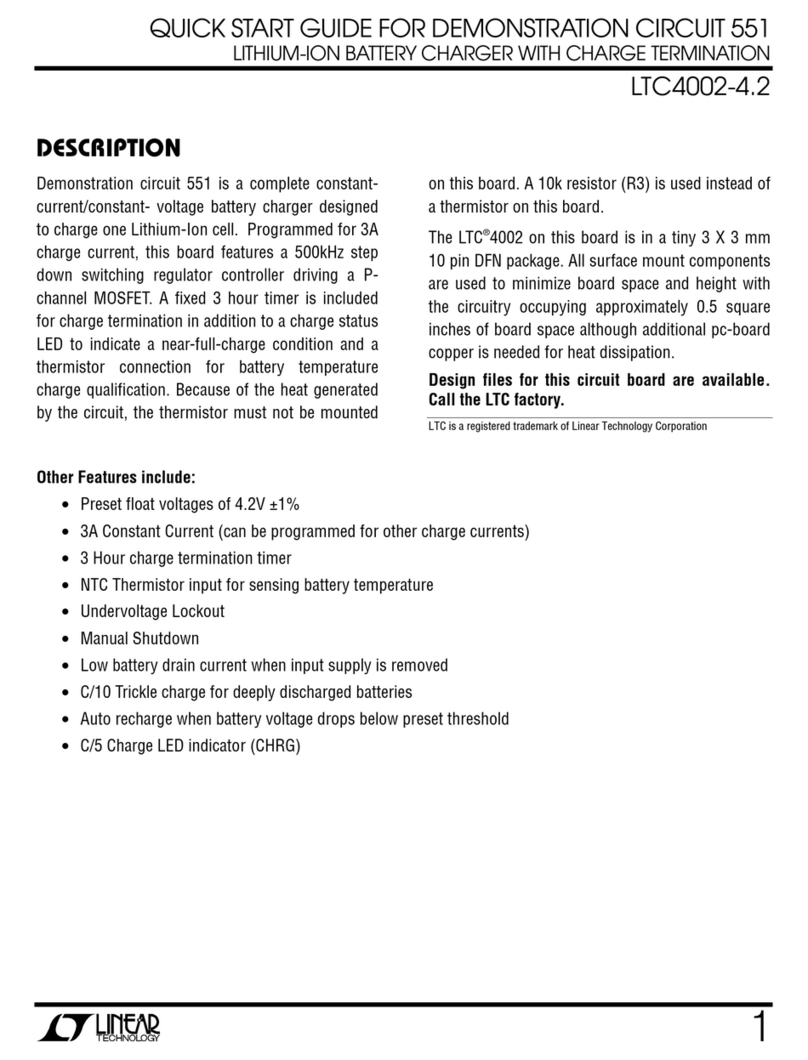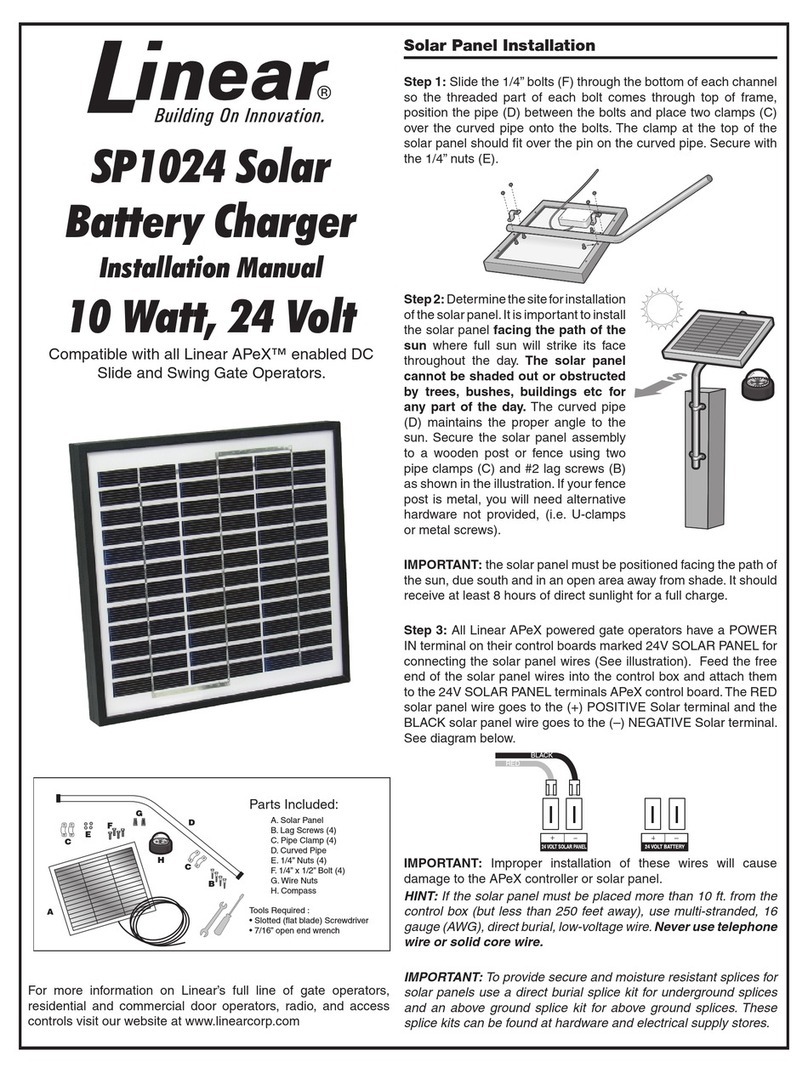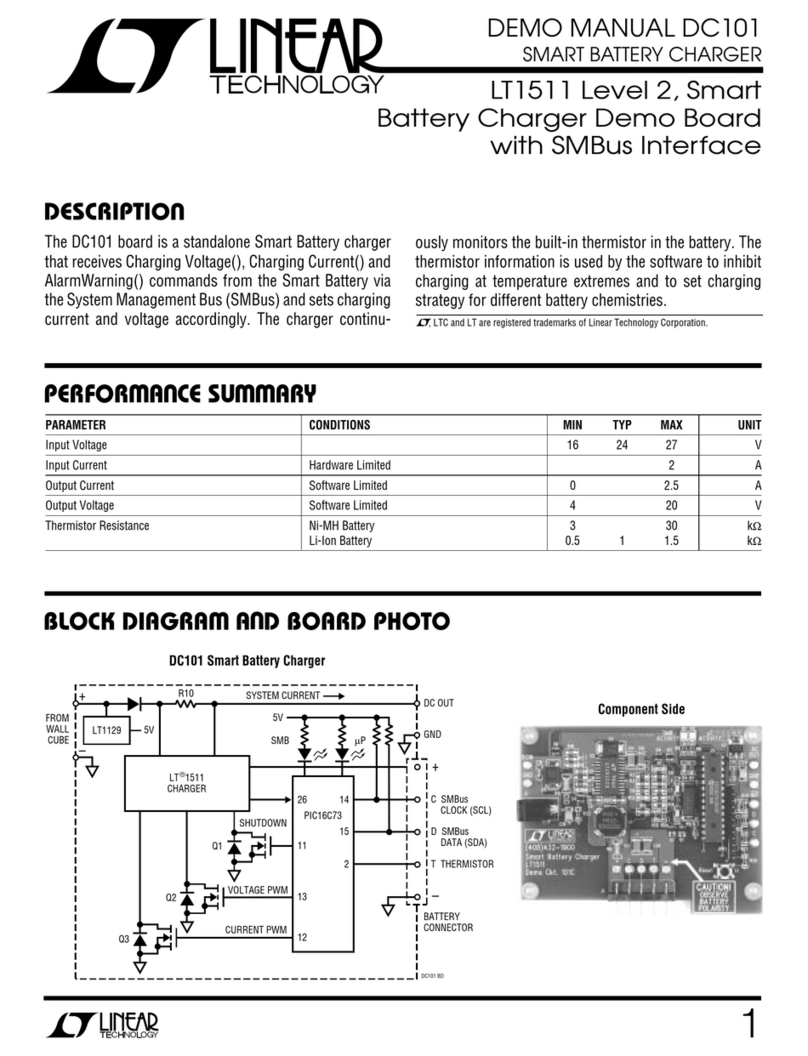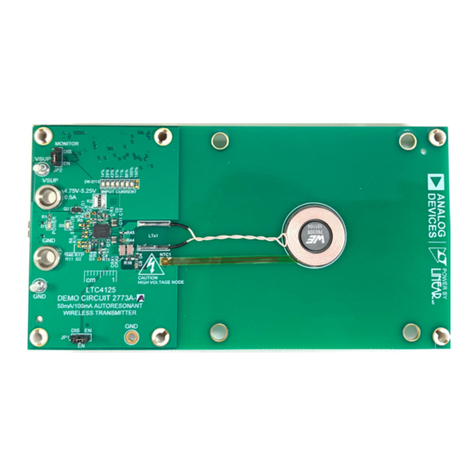Linear LTC4050 User manual

QUICK START GUIDE FOR DEMO CIRCUITS 530A-A AND 530A-B
LI-ION BATTERY CHARGER
LTC4050
DESCRIPTION
Demonstration circuit 530A-A and 530A-B are complete
constant-current/constant-voltage battery chargers de-
signed to charge one Lithium-Ion cell. Both feature the
LTC4050 Linear Battery Charger driving a P-channel
MOSFET in a series pass linear regulator configuration
for charging at a maximum current of 700mA (limited by
the power dissipation capabilities of the pass transistor).
Demo board LTC4050A-A features the LTC4050-4.1,
which has a recharge threshold voltage of 3.88V, making
it suitable for charging 4.1V cells.
Demo board LTC4050A-B features the LTC4050-4.2,
which is recommended only for charging a 4.2V cell,
due to its recharge threshold voltage of 3.98V.
Other Features include:
•
Preset float voltages of 4.1 and 4.2V ±1%
•
700mA Constant Current (can be programmed for
other charge currents)
•
3-hour charge termination timer. This timer can be set
for other time periods through a capacitor change.
For instance, you may want to use a much shorter pe-
riod (on the order of 30 seconds) when evaluating the
board with a battery simulator instead of a Li-Ion bat-
tery.
•
Manual Shutdown
•
C/10 Trickle charge for deeply discharged batteries
•
Auto recharge when battery voltage drops below pre-
set threshold (3.88V for DC530A-A and 3.98V for
DC530A-B).
•
Low battery drain current when the input supply is
removed
•
Input Power OK LED indicator (ACPR)
•
C/10 Charge LED indicator (CHRG)
•
NTC Input to prevent charging if the battery is too hot
or too cold
Small surface mount components are used to minimize
board space and height with the circuitry occupying ap-
proximately 0.15 square inches of board space with a
height of 0.054 inches (1.4mm).
Design files for this circuit board are available. Call
the LTC factory.
Table 1.
Performance Summary
PARAMETER VALUE
Input Voltage Range 4.5V to 6.0V (upper range limited by MOSFET dissipation)
Output Voltage V
BAT
(constant voltage mode) 4.1V ±1% DC530A-A
4.2V ±1% DC530A-B
Output Current I
BAT
(constant current mode) 700mA ±8%
Output Current I
BAT
(trickle current mode) 70mA ±70%
C/10 CHRG LED Threshold Level 35-140mA
Trickle Charge Threshold Voltage 2.49V
Battery Drain Current with V
IN
Removed 5µA
Note: If V
IN
is pulled down to 0V, the current drain from the battery will be higher due to the leak-
age current of the input Schottky diode. A silicon diode could be used for the input diode if the
slightly greater forward voltage drop is not a problem.
1

QUICK START GUIDE FOR DEMO CIRCUITS 530A-A AND 530A-B
LI-ION BATTERY CHARGER
QUICK START PROCEDURE
Demonstration circuits 530A-A and 530A-B are easy to
set up to evaluate the performance of the LTC4050. Re-
fer to Figure 1 for proper measurement equipment setup
and follow the procedure below:
1.
Install jumper JP1 in the PROG position
to enable the
charger.
2.
Set the input power supply to 0V, and then connect it
to the VIN and GND pins of the demo board.
3.
Set the battery simulator to 0V, and then connect it to
the BAT and GND pins.
4.
Connect the digital voltmeters as shown in the setup
diagram to measure VIN, charger voltage (VBAT) and
the charge current (IBAT).
5.
Start the demo board evaluation by increasing the
input power supply to approximately 3.8V (battery
simulator power supply set for 0V). The charger out-
put voltage and charge current should be 0. The
CHRG and ACPR LEDs should be off.
The charger is
off due to the undervoltage lockout feature.
6.
Increase the input voltage to 5V and keep the battery
simulator power supply at 0V. Both LEDs (CHRG and
ACPR) should now be on, the charger output voltage
(VBAT) should be approximately 140mV, and the
charge current should be approximately 70mA.
This
is the trickle charge mode for a deeply discharged
battery.
Typically, a battery that has not been charged
for a long time.
7.
Starting from 0V, slowly increase the battery simula-
tor power supply (VBAT), observing the charger’s
output voltage on the DVM. When the charger’s out-
put voltage exceeds approximately 2.5V, the charger
will suddenly enter the Constant current portion of the
charge cycle resulting in an abrupt increase in charge
current (IBAT) to the programmed value of approxi-
mately 700mA.
This is the constant current mode.
8.
Continue slowly increasing the battery simulator
power supply, thus simulating a battery accepting
charge. The charge current should remain at the pro-
grammed value of 700mA until the charger output
voltage is within approximately 10mV of the preset
charge voltage, at which time the charge current will
begin to decrease.
This is the beginning of the con-
stant voltage portion of the charge cycle.
9.
Continue slowly increasing the battery simulator
power supply until the charge current drops to ap-
proximately 200mA, and then read the charger output
voltage.
This reading is the charger float voltage
(VBAT) which will be either 4.1V or 4.2V ± 40mV
depending on the demo board version.
10.
Place jumper JP1 in the SHDN position. The charger
will shut down, dropping the charge current to 0mA.
The ACPR LED remains on and the charge LED goes
out.
11.
Return JP1 to the PROG position.
12.
Continue slowly increasing the battery simulator
power supply while observing the CHRG LED. The
LED will go out when the charge current drops to ap-
proximately 10% of the programmed charge current
of 700mA.
This verifies that the C/10 output is oper-
ating correctly.
The current through the LED drops from approxi-
mately 10mA when the LED is on, to approximately
30µA when the charge current drops to 10%, and
drops to 0µA after the timer has timed out (3 hours
when a 0.1µF timing capacitor is used).
At C/10, when the CHRG LED goes out, the battery is
approximately 94% charged. The charger will con-
tinue charging for a total of 3 hours (0.1µF timing ca-
pacitor) and then stop, at which point the battery is
approximately 99% charged.
NOTE:
For evaluation purposes, the time can be de-
creased from the programmed 3 hours to approxi-
mately 30 seconds by reducing the timer capacitor
(C3) from 0.1µF to 270pF.
13.
After the timer has timed out, slowly decrease the
battery simulator power supply. At approximately
3.88V for demo board DC530A-A, a new 700mA
charge cycle begins. With demo board DC530A-B,
2

QUICK START GUIDE FOR DEMO CIRCUITS 530A-A AND 530A-B
LI-ION BATTERY CHARGER
this should occur at approximately 3.98V.
This is the
Recharge Threshold Voltage.
14.
To verify battery drain current, remove the input sup-
ply voltage, and set the battery simulator power sup-
ply to approximately 4V.
The charge current DVM will
now read battery drain current.
If V
IN
is pulled down to 0V, the current drain from the
battery will be higher due to the leakage current of the
input Schottky diode. A silicon diode could be used
for the input diode if the slightly greater forward volt-
age drop is not a problem.
15.
Operation of the NTC function is verified as follows.
Placing a 5k resistor from the NTC pin to GND can
simulate too hot operation. In order to verify too cold
operation R7 has to be removed and replaced by a
33k resistor. While charging is inhibited by an out of
spec NTC both the CHRG and ACPR LEDs will be ON.
+
–
+
–
+
–
+
–
JP2D3
2Ω
10W
PRELOAD
MEASURE
CHARGE
CURRENT
(IBAT)
RECOMMENDED
LI-ION BATTERY SIMULATOR*
D2
CHRG
ACPR
SHDN
R7
VBAT
+–
* CAN USE A LI-ION BATTERY,
THOUGH TESTING TAKES MORE TIME
VIN
GND
BAT
SHDN
NTC
GND
INPUT POWER SUPPLY
0–6V
1A
DO NOT EXCEED 6V
MOSFET WILL OVERHEAT
BATTERY
SIMULATOR
BENCH
POWER SUPPLY
0V–4.3V
2A
WITH COURSE
AND FINE
VOLTAGE
ADJUSTMENT
LTC4050EMS
Li-Ion Battery Charger
Demo Circuit DC530A-A or B
Linear Technology (408) 432-1900 www.linear.com
Figure 1.
Proper Measurement Equipment Setup
NOTE:
Although it would take more time, this charger can also be evaluated using a rechargeable Li-Ion battery in
place of the battery simulator pictured here. If you use a real battery, keep the DC resistance between the charger and
the battery to a minimum, as this will affect the charge current in the constant voltage mode.
3

QUICK START GUIDE FOR DEMO CIRCUITS 530A-A AND 530A-B
LI-ION BATTERY CHARGER
4.2V
4.0V
3.8V
3.6V
3.4V
3.2V
3.0V
2.8V
700mA
600mA
500mA
400mA
300mA
200mA
100mA
0
0 2 0 4 0 6 0 8 0 100 120 140 160 180
0.5 Hr 1 Hr 1.5 Hr 2 Hr 2.5 Hr 3 Hr
Minutes
Hours
60˚
50˚
40˚
30˚
Timer
Stops
C/10
LED
OFF
Charge Current
Battery Voltage
Constant Current Mode Constant Voltage Mode
TIME (minutes or hours)
CHARGE VOLTAGE (V)
CHARGE CURRENT (mA)
Timer Capacitor = 0.1µF
Ta = 25˚C
Figure 2.
Typical Charge Cycle Using DC530A-A
4

5
5
4
4
3
3
2
2
1
1
D D
C C
B B
A A
Li-lon Cell
BAT
Single
+VIN
EXT. NTC
GND
4.5V - 6V
GND
EXT. PROG / SHDN
PROG
SHDN
VERSION
VERSION TABLE
U1
Battery Voltages
*
*
DC530A-A
DC530A-B
4.1V
4.2V
LTC4050EMS-4.1
LTC4050EMS-4.2
CHRG
ACPR
A
DC530A
Tuesday, July 09, 2002
11
LTC4050EMS, Li-Ion Battery Charger with NTC
June Wu 4/30/02
Fran Hoffart 4/30/02
SIZE
SCALE:
CAGE CODE DWG NO REV
SHEET OF
FILENAME:
TITLE
CONTRACT NO.
APPROVALS DATE
DRAWN
CHECKED
APPROVED
ENGINEER
DESIGNER
TECHNOLOGY
1630 McCarthy Blvd.
Milpitas, CA 95035
Phone: (408)432-1900
Fax: (408)434-0507
VCC
D1
MBRM120LT3
1 2
R2
18.7K
D2
RED
2 1
D3
GRN
2 1
C1
1uF
16V
R4
330
E1
Q1
SI3443DV
3
41
2
5
6
U1
LTC4050EMS
8
3
10
4
5
67
9
1
2
VCC
CHRG
ACPR
TIMER
GND
PROG DRV
SENSE
BAT
NTC
E3
R3
330
C3
0.1uF
16V
E5
JP1
1
2
3
R1
0.15
1/4W
R7
10K
E4
R6
1 ohm
E6
E2
C2
4.7uF
6.3V
Table of contents
Other Linear Batteries Charger manuals
